Elections in Wales
There are four types of elections in Wales: elections to the House of Commons of the United Kingdom, elections to the devolved Senedd (Welsh Parliament; Welsh: Senedd Cymru), local elections to the 22 principal areas, and the Police and Crime Commissioner elections, in addition to by-elections for each aforementioned election. Elections are held on Election Day, which is conventionally a Thursday. Since the passing of the Fixed-term Parliaments Act 2011 for UK general elections, all four types of elections are held after fixed periods, though early elections to the UK parliament can occur in certain situations, with Senedd elections being postponed to avoid elections to the UK parliament and Senedd coinciding with each other.
| This article is part of a series within the Politics of the United Kingdom on the |
| Politics of Wales |
|---|
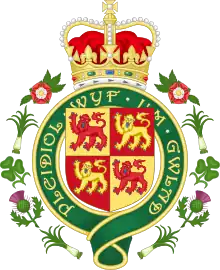 |
|
The three electoral systems used for elections in Wales are: first-past-the-post (for UK elections and local elections, though individual local authorities are able to move to STV under recent Welsh legislation), the additional member system (for Senedd elections) and the supplementary vote (for Police and Crime Commissioner elections; although proposals by the UK Government to change PCC elections to FPTP have been made).
Local government elections

There are elections to 22 unitary authorities across Wales every four years, most recently on 5 May 2022. The electoral system used is first-past-the-post. The largest unitary authorities in Wales are Cardiff, Newport and Swansea councils, which all lie in the southern coastal belt.
- The next Welsh local elections are scheduled for 2027
- Local election results 2022
- Local election results 2017
- Local election results 2012
- Local election results 2008
- Local election results 2004
- Local election results 1999
- Local election results 1995
- Local election results 1993
Police and crime commissioner elections
Police and crime commissioners were established in England and Wales, replacing the local police authorities, following the Conservative–Liberal Democrat coalition agreement of 2010, with the first Police and crime commissioners elected in 2012.
Devolved parliament elections
There have been six elections to the devolved parliament of Wales, based in Cardiff Bay since 1999. These elections are held every five years to elect sixty Members of the Senedd (MSs; formerly Assembly Members, ASs). Voters have two votes: forty MSs are elected by the First Past the Post system in individual constituencies, and a further twenty MSs are elected by a regional top-up system in which voters vote by region. This system overall is called Additional Members System (AMS) and is a hybrid electoral system mixing both a plurality system (FPTP) and a proportional system (the party list system). The regions are: Mid and West Wales, North Wales, South Wales Central, South Wales East and South Wales West, whereas the constituencies are the same used for elections to the UK parliament. Each region elects four MSs, to achieve approximately proportional representation overall, with every individual in Wales being represented by five MSs in total, their local constituency MS and four regional MSs. Between its inception in 1999, it was known as the 'National Assembly for Wales'. Legislation was passed in 2020, for a name change on 6 May 2020 to its current name, 'Senedd Cymru' or the 'Welsh Parliament' (or simply 'Senedd') to fully reflect its constitutional status as a law-making and tax-setting parliament.[1] It is based in Cardiff Bay, initially (as the Assembly) in Tŷ Hywel from 1999 to 2006, until it moved to the Senedd building, which opened on 1 March 2006, where the Assembly and now Senedd has been based since 2006. The elections were held every four years from 1999, but were increased to five years following the Wales Act 2014 for the 2016 election.
The 2021 Senedd election on 6 May 2021, was the first election to the devolved parliament since its name change. The election took place akin to previous elections when it was known as the National Assembly for Wales.
Election reform
The Richard Commission report of 2004 suggested an increase of the number of Members to 80. That number was also suggested, as a minimum, by the 2014 report of the Silk Commission.[2] Similarly, in 2013 and 2016, the Electoral Reform Society published reports making the case for an upsize of the Assembly.[3][4] A 2017 report of an expert commission suggested an increase to between 80 and 90 Members, switching to single transferable vote (STV) and enforcing gender quotas.[2]
A reduction in the number of Welsh MPs has been proposed for the next UK general alection. Under the proposals, the number of MPs would be reduced from 40 to 32 and new constituency boundaries have also been proposed.[5] The boundary plans were published on 19 October 2022 and voters have four weeks to comment. The map of the new constituency boundaries would also be used as Senedd regions for the next Senedd election.[6]
The Special Committee was set up on 6 October 2021.[7] In May 2022, a joint position statement was published by First Minister Mark Drakeford and Plaid Cymru Leader Adam Price,[8] calling for a 96-Member Senedd, all elected through closed party list proportional representation (using the D'Hondt method) with mandatory "zipping" of male and female candidates in the list to ensure that for every party, half of the Members will be women.[9]
The final report of the Special Committee was published on 30 May 2022 and recommended the system agreed to by the Labour and Plaid Cymru leaders.[10]
Senedd Cymru (Members and Elections) Bill
In September 2023, the Welsh Government published its plans for electoral reform as part of the proposed Senedd Cymru (Members and Elections) Bill. The number of Senedd constituencies is set to fall to 16, with each constituency electing six MSs from a closed list under the D'Hondt method. Under the proposals, all candidates must live in Wales, and elections would take place every four years, rather than five.[11]
as the Senedd
Elections to the institution prior to 2020, with the last being in 2016, were done under the previous name the 'National Assembly for Wales' (see below). Following legislation in 2020, any subsequent elections, from the 2021 Senedd election will be under its new name.
2026
The next Senedd election is expected to be held on Thursday 7 May 2026, under the provisions of the Wales Act 2014 where Senedd terms are five-year terms. This date can be postponed under circumstances including public health or safety emergencies, or an early UK parliamentary election (itself expected in 2024, but can be held prior).
2021
It was the sixth general election since the establishment of the institution in 1999. It was held along with the other 2021 United Kingdom local elections and was the first election where 16 and 17-year-olds were allowed to vote in Wales, which is the largest extension of the franchise in Wales since 1969. Both changes were a result of the Senedd and Elections (Wales) Bill 2019.[12]
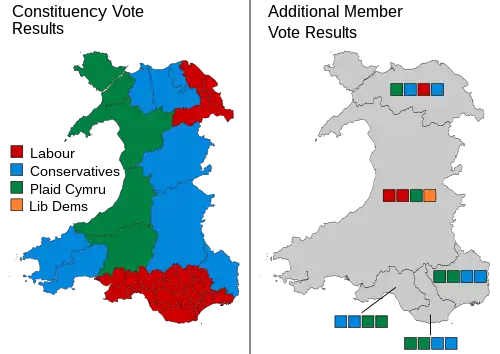
Overall turnout: 46.5%
as the National Assembly for Wales (1999–2020)
Elections to the then 'National Assembly for Wales' (or Welsh Assembly') occurred from its first election in 1999 up until the 2016 election (with any subsequent elections being as the 'Senedd'). This follows the 1997 devolution referendum where Welsh voters narrowly approved the formation of the devolved institution. The institution is now known as the Senedd (Welsh Parliament; Welsh: Senedd Cymru) (see above).
2016
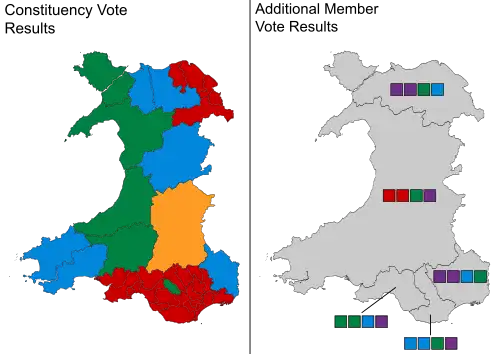
Overall turnout: 45.3%
2011
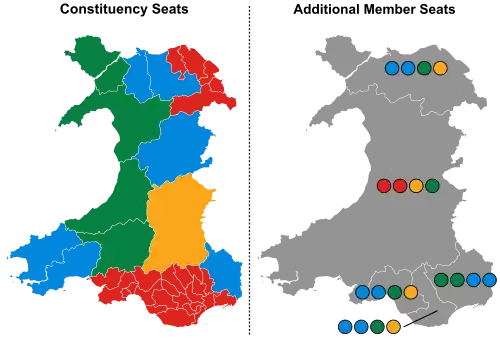
Overall turnout: 42.2%
2007
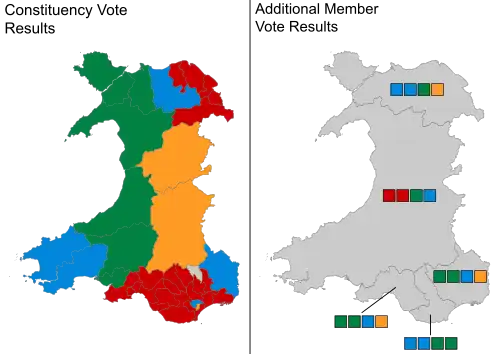
Overall turnout: 43.7%
2003
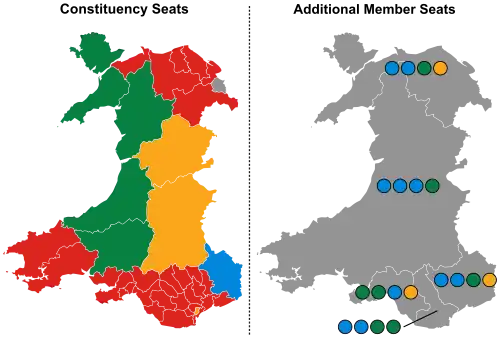
Overall turnout: 38.2%
1999
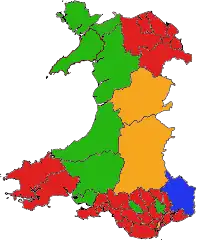
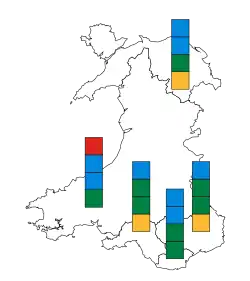
Overall turnout: 46%
Past elections and referendums
UK parliament elections


Wales has been eligible to send MPs to Westminster since the Laws in Wales Act 1535. Between then and 1885, most constituencies were categorised as county or borough constituencies; each sent one MP to Westminster. As the Industrial Revolution took hold there were many calls for reform (particularly in towns such as Merthyr Tydfil). Parliament eventually allowed the new towns to vote, and this introduced the first Labour MPs. The first leader of the Labour Party in Parliament, Keir Hardie, was one of the two MPs for Merthyr Tydfil. The following table shows the composition of Wales' Westminster MPs since 1885.
| Year | Labour | Liberal Democrat/ Liberal |
Conservative | Plaid Cymru | Independent | Liberal Unionist | Independent Labour | Others |
|---|---|---|---|---|---|---|---|---|
| 1885 | - | 29 | 4 | - | - | - | - | 1 |
| 1886 | - | 26 | 6 | - | - | 1 | - | 1 |
| 1892 | - | 30 | 3 | - | - | - | - | 1 |
| 1895 | - | 24 | 8 | - | - | 1 | - | 1 |
| 1900 | 1 | 26 | 6 | - | - | 1 | - | 1 |
| 1906 | 1 | 28 | - | - | - | - | 1 | - |
| 1910 (Jan) | 5 | 27 | 2 | - | - | - | - | - |
| 1910 (Dec) | 6 | 26 | 3 | - | - | - | 1 | - |
| 1918 | 9 | 3 | 4 | - | - | - | - | 19 |
| 1922 | 18 | 2 | 6 | - | - | - | 1 | 9 |
| 1923 | 19 | 11 | 4 | - | - | - | - | 2 |
| 1924 | 16 | 11 | 9 | - | - | - | - | - |
| 1929 | 25 | 10 | 1 | - | - | - | - | - |
| 1931 | 15 | 5 | 6 | - | - | - | 1 | 9 |
| 1935 | 18 | 8 | 6 | - | - | - | - | 4 |
| 1945 | 25 | 7 | 3 | - | - | - | - | 1 |
| 1950 | 27 | 5 | 3 | - | - | - | - | 1 |
| 1951 | 27 | 3 | 5 | - | - | - | - | 1 |
| 1955 | 27 | 3 | 5 | - | - | - | - | 1 |
| 1959 | 27 | 2 | 6 | - | - | - | - | 1 |
| 1964 | 28 | 2 | 6 | - | - | - | - | - |
| 1966 | 32 | 1 | 3 | - | - | - | - | - |
| 1970 | 27 | 1 | 7 | - | - | - | 1 | - |
| 1974 (Feb) | 24 | 2 | 8 | 2 | - | - | - | - |
| 1974 (Oct) | 23 | 2 | 8 | 3 | - | - | - | - |
| 1979 | 22 | 1 | 11 | 2 | - | - | - | - |
| 1983 | 20 | 2 | 14 | 2 | - | - | - | - |
| 1987 | 24 | 3 | 8 | 3 | - | - | - | - |
| 1992 | 27 | 1 | 6 | 4 | - | - | - | - |
| 1997 | 34 | 2 | - | 4 | - | - | - | - |
| 2001 | 34 | 2 | - | 4 | - | - | - | - |
| 2005 | 29 | 4 | 3 | 3 | 1 | - | - | - |
| 2010 | 26 | 3 | 8 | 3 | - | - | - | - |
| 2015 | 25 | 1 | 11 | 3 | - | - | - | - |
| 2017 | 28 | - | 8 | 4 | - | - | - | - |
| 2019 | 22 | - | 14 | 4 | - | - | - | - |
2019
| Party[13] | Seats | Votes | |||||||
|---|---|---|---|---|---|---|---|---|---|
| Total | Gains | Losses | Net +/- | % seats | Total | % | Change | ||
| Labour | 22 | 0 | 6 | 55 | 632,035 | 40.9 | |||
| Conservative | 14 | 6[lower-alpha 1] | 0 | 35 | 557,234 | 36.1 | |||
| Plaid Cymru | 4 | 0 | 0 | 10 | 153,265 | 9.9 | |||
| Liberal Democrats | 0 | 0 | 0[lower-alpha 2] | 0 | 92,171 | 6.0 | |||
| Brexit Party | 0 | 0 | 0 | 0 | 83,908 | 5.4 | new | ||
| Green | 0 | 0 | 0 | 0 | 15,828 | 1.0 | |||
| Independents | 0 | 0 | 0[lower-alpha 3] | 0 | 6,220 | 0.4 | N/A | ||
| Gwlad | 0 | 0 | 0 | 0 | 1,515 | 0.1 | new | ||
| Cynon Valley | 0 | 0 | 0 | 0 | 1,322 | 0.1 | new | ||
| Monster Raving Loony | 0 | 0 | 0 | 0 | 345 | 0.0 | |||
| Christian | 0 | 0 | 0 | 0 | 245 | 0.0 | new[lower-alpha 4] | ||
| SDP | 0 | 0 | 0 | 0 | 181 | 0.0 | new[lower-alpha 4] | ||
| Socialist Alternative | 0 | 0 | 0 | 0 | 88 | 0.0 | new[lower-alpha 5] | ||
| Total | 40 | 1,544,357 | Turnout | 66.6 | |||||
- Not including Brecon and Radnorshire and Aberconwy, which the Conservative Party won in 2017 but did not control when parliament was dissolved.
- Not including Brecon and Radnorshire, which the Liberal Democrats won in a 2019 by-election.
- Not including Aberconwy, previously controlled by the independent Guto Bebb who lost the Conservative Party whip in 2019.
- Party entered candidates in the 2017 general election but not in any Welsh seats.
- Party has entered candidates in past general elections but not the 2017 general election.
2017
| Party | Seats | Votes | |||||||
|---|---|---|---|---|---|---|---|---|---|
| Total | Gains | Losses | Net +/- | % seats | Total | % | Change | ||
| Labour | 28 | 3 | 0 | 70.0 | 771,354 | 48.9 | |||
| Conservative | 8 | 0 | 3 | 20.0 | 528,839 | 33.6 | |||
| Plaid Cymru | 4 | 1 | 0 | 10.0 | 164,466 | 10.4 | |||
| Liberal Democrats | 0 | 0 | 1 | — | 71,039 | 4.5 | |||
| UKIP | 0 | 0 | 0 | 0 | — | 31,376 | 2.0 | ||
| Green | 0 | 0 | 0 | 0 | — | 5,128 | 0.3 | ||
| Others | 0 | 0 | 0 | 0 | — | 3,612 | 0.2 | ||
| Total | 40 | 1,575,814 | Turnout | 68.6 | |||||
2015
| Party | Seats | Votes | |||||||
|---|---|---|---|---|---|---|---|---|---|
| Total | Gains | Losses | Net +/- | % seats | Total | % | Change | ||
| Labour | 25 | 1 | 2 | 62.5 | 552,473 | 36.9 | |||
| Conservative | 11 | 3 | 0 | 27.5 | 407,813 | 27.2 | |||
| UKIP | 0 | 0 | 0 | — | 204,330 | 13.6 | |||
| Plaid Cymru | 3 | 0 | 0 | 7.5 | 181,704 | 12.1 | |||
| Liberal Democrats | 1 | 0 | 2 | 2.5 | 97,783 | 6.5 | |||
| Green | 0 | 0 | 0 | — | 38,344 | 2.6 | |||
| Socialist Labour | 0 | 0 | 0 | — | 3,481 | 0.2 | |||
| TUSC | 0 | 0 | 0 | — | 1,780 | 0.1 | |||
| Others | 0 | 0 | 0 | — | 10,355 | 0.7 | |||
| Total | 40 | 1,498,063 | |||||||
2010
| Party | Seats | Votes | |||||||
|---|---|---|---|---|---|---|---|---|---|
| Total | Gains | Losses | Net +/- | % seats | Total | % | Change | ||
| Labour | 26 | 1 | 5 | 65.0 | 531,601 | 36.2 | |||
| Conservative | 8 | 5 | 0 | 20.0 | 382,730 | 26.1 | |||
| Liberal Democrats | 3 | 0 | 1 | 7.5 | 295,164 | 20.1 | |||
| Plaid Cymru | 3 | 1 | 0 | 7.5 | 165,394 | 11.3 | |||
| UKIP | 0 | 0 | 0 | 0 | — | 35,690 | 2.4 | ||
| BNP | 0 | 0 | 0 | 0 | — | 23,088 | 1.6 | ||
| Green | 0 | 0 | 0 | 0 | — | 6,293 | 0.4 | ||
| Christian | 0 | 0 | 0 | 0 | — | 1,947 | 0.1 | N/A | |
| TUSC | 0 | 0 | 0 | 0 | — | 341 | 0.0 | N/A | |
| Others | 0 | 0 | 1 | — | 24,442 | 1.7 | |||
| Total | 40 | 1,466,690 | 64.9 | ||||||
2005
| Party | Candidates | Seats | Seats change |
Votes | % | % change | |
|---|---|---|---|---|---|---|---|
| Labour | 29 | 594,821 | 42.7 | ||||
| Conservative | 3 | 297,830 | 21.4 | ||||
| Liberal Democrats | 4 | 256,249 | 18.4 | ||||
| Plaid Cymru | 3 | 174,838 | 12.6 | ||||
| UKIP | 0 | 20,297 | 1.5 | ||||
| Green | 0 | 7,144 | 0.5 | ||||
| Forward Wales | 0 | 3,461 | 0.2 | ||||
| Legalise Cannabis | 0 | 1,772 | 0.1 | ||||
| BNP | 0 | 1,689 | 0.1 | ||||
| Socialist Labour | 0 | 1,605 | 0.1 | ||||
| Veritas | 0 | 1,437 | 0.1 | ||||
| Respect | 0 | 643 | 0.0 | ||||
| Liberal | 0 | 605 | 0.0 | ||||
| Socialist Alliance | 0 | 557 | 0.0 | ||||
| Communist | 0 | 440 | 0.0 | ||||
| Yourself | 0 | 284 | 0.0 | ||||
| Bean Party | 0 | 159 | 0.0 | ||||
| Independent | 1 | 28,888 | 2.3 | ||||
| Turnout: | 1,392,719 | 62.4 | |||||
2001
| Party | Candidates | Seats | Seats change |
Votes | % | % change | |
|---|---|---|---|---|---|---|---|
| Labour | 40 | 34 | 666,956 | 48.6 | |||
| Conservative | 40 | 0 | 288,623 | 21.0 | |||
| Plaid Cymru | 40 | 4 | 195,893 | 14.3 | |||
| Liberal Democrats | 2 | 189,254 | 13.8 | ||||
| UKIP | 0 | 12,552 | 0.9 | ||||
| Green | 0 | 3,753 | 0.3 | ||||
| Socialist Labour | 0 | 2,805 | 0.2 | ||||
| Socialist Alliance | 0 | 2,258 | 0.2 | ||||
| ProLife Alliance | 0 | 1,609 | 0.1 | ||||
| Communist | 0 | 384 | 0.0 | ||||
| BNP | 0 | 278 | 0.0 | ||||
| Others | 7,959 | 0.6 | |||||
| Turnout: | 1,372,324 | 61.6 | |||||
1997
| Party[14] | Seats | Votes | |||||||
|---|---|---|---|---|---|---|---|---|---|
| Total | Gains | Losses | Net +/- | % seats | Total votes | % votes | Change | ||
| Labour | 34 | 7 | 0 | 85.0 | 885,935 | 54.7 | |||
| Conservative | 0 | 0 | 8 | — | 317,127 | 19.6 | |||
| Liberal Democrats | 2 | 1 | 0 | 5.0 | 200,020 | 12.4 | |||
| Plaid Cymru | 4 | 0 | 0 | 10.0 | 161,030 | 10.0 | |||
| Referendum | 0 | 0 | 0 | — | 38,245 | 2.4 | New | ||
| Socialist Labour | 0 | 0 | 0 | — | 6,203 | 0.4 | New | ||
| Independent Labour | 0 | 0 | 0 | — | 4,633 | 0.3 | New | ||
| Independent | 0 | 0 | 0 | — | 2,258 | 0.2 | N/A | ||
| Green | 0 | 0 | 0 | — | 1,718 | 0.1 | |||
| Other parties | 0 | 0 | 0 | — | 3,087 | 0.2 | N/A | ||
1992
| Party[15] | Seats | Votes | |||||||
|---|---|---|---|---|---|---|---|---|---|
| Total | Gains | Losses | Net +/- | % seats | Total votes | % votes | Change | ||
| Labour | 27 | 3 | 0 | 71.1 | 865,663 | 49.5 | |||
| Conservative | 6 | 1 | 3 | 15.8 | 499,677 | 28.6 | |||
| Liberal Democrats | 1 | 0 | 2 | 2.6 | 217,457 | 12.4 | |||
| Plaid Cymru | 4 | 1 | 0 | 10.5 | 156,747 | 9.0 | |||
| Others | 0 | 0 | 0 | — | 9,233 | 0.5 | |||
1987
| Party | Seats | Votes | |||||||
|---|---|---|---|---|---|---|---|---|---|
| Total | Gains | Losses | Net +/- | % seats | Total votes | % votes | Change | ||
| Labour | 24 | 4 | 0 | 63.2 | 765,209 | 45.1 | |||
| Conservative | 8 | 0 | 6 | 21.1 | 501,316 | 29.5 | |||
| Alliance | 3 | 1 | 0 | 7.9 | 304,230 | 17.9 | |||
| Plaid Cymru | 3 | 1 | 0 | 7.9 | 123,599 | 7.3 | |||
| Others | 0 | 0 | 0 | — | 3,742 | 0.2 | |||
1983
| Party | Seats | Votes | |||||||
|---|---|---|---|---|---|---|---|---|---|
| Total | Gains | Losses | Net +/- | % seats | Total votes | % votes | Change | ||
| Labour | 20 | 0 | 3 | 52.6 | 603,858 | 37.5 | |||
| Conservative | 14 | 3 | 1 | 36.8 | 499,310 | 31.0 | |||
| Alliance | 2 | 1 | 0 | 5.3 | 373,358 | 23.2 | |||
| Plaid Cymru | 2 | 0 | 0 | 5.3 | 125,309 | 7.8 | |||
| Other parties | 0 | 0 | 0 | — | 7,151 | 0.4 | |||
European Parliament
Wales was a constituency in European Parliament elections. Following the United Kingdom's exit from the European Union on 31 January 2020, Wales no longer elects representatives to the European Parliament.
2019
| European Election 2019: Wales[17][18] | |||||
|---|---|---|---|---|---|
| List | Candidates | Votes | % | ± | |
| Brexit Party | Nathan Gill (1) James Wells (3) Gethin James, Julie Price |
271,404 (135,702) |
32.46 | ||
| Plaid Cymru | Jill Evans (2) Carmen Smith, Patrick McGuinness, Ioan Bellin |
163,928 | 19.60 | ||
| Labour | Jacqueline Jones (4) Matthew Dorrance, Mary Wimbury, Mark Whitcott |
127,833 | 15.29 | ||
| Liberal Democrats | Sam Bennett, Donna Lalek, Alistair Cameron, Andrew Parkhurst | 113,885 | 13.62 | ||
| Conservative | Daniel Boucher, Craig Lawton, Fay Jones, Tomos Davies | 54,587 | 6.53 | ||
| Green | Anthony Slaughter, Ian Chandler, Ceri Davies, Duncan Rees | 52,660 | 6.30 | ||
| UKIP | Kristian Hicks, Keith Edwards, Thomas Harrison, Robert McNeil-Wilson | 27,566 | 3.30 | ||
| Change UK | Jon Owen Jones, June Davies, Matthew Paul, Sally Anne Stephenson | 24,332 | 2.91 | ||
| Turnout | 836,195 | 37.1 | |||
2019 opinion polls
| Date(s) | Polling organisation/client | Sample | Lab | UKIP | Con | Plaid | Green | Lib Dems | Brexit | Change UK | Others | Lead |
|---|---|---|---|---|---|---|---|---|---|---|---|---|
| 16–20 May 2019 | YouGov/ITV | 1,009 | 15% | 2% | 7% | 19% | 8% | 10% | 36% | 2% | 0% | 17% |
| 10–15 May 2019 | YouGov/Plaid Cymru | 1,133 | 18% | 3% | 7% | 16% | 8% | 10% | 33% | 4% | 0% | 15% |
| 2–5 April 2019 | YouGov/ITV | 1,025 | 30% | 11% | 16% | 15% | 5% | 6% | 10% | 8% | 1% | 14% |
| 22 May 2014 | 2014 EU election results | 733,060 | 28.2% | 27.6% | 17.4% | 15.3% | 4.5% | 4.0% | N/A | N/A | 3.2% | 0.6% |
2014
| European Election 2014: Wales | |||||
|---|---|---|---|---|---|
| List | Candidates | Votes | % | ± | |
| Labour | Derek Vaughan Jayne Bryant, Alex Thomas, Christina Rees[19][20] |
206,332 | 28.15 | +7.9 | |
| UKIP | Nathan Gill James Cole, Caroline Jones, David Rowlands[20][21] |
201,983 | 27.55 | +14.8 | |
| Conservative | Kay Swinburne Aled Davies, Dan Boucher, Richard Hopkin[20][22] |
127,742 | 17.43 | −3.8 | |
| Plaid Cymru | Jill Evans Marc Jones, Stephen Cornelius, Ioan Bellin[20][23][24] |
111,864 | 15.26 | −3.3 | |
| Green | Pippa Bartolotti, John Matthews, Chris Were, Rosemary Cutler[20][25][26] | 33,275 | 4.54 | −1.0 | |
| Liberal Democrats | Alec Dauncey, Robert Speht, Jackie Radford, Bruce Roberts[20] | 28,930 | 3.95 | −6.7 | |
| BNP | Mike Whitby, Laurence Reid, Jean Griffin, Gary Tumulty[20] | 7,655 | 1.04 | −4.4 | |
| Britain First | Paul Golding, Anthony Golding, Christine Smith, Anne Elstone[20] | 6,633 | 0.9 | 0.00 | |
| Socialist Labour | Andrew Jordan, Katherine Jones, David Lloyd Jones, Liz Screen[20] | 4,459 | 0.61 | −1.2 | |
| NO2EU | Robert Griffiths, Claire Job, Steve Skelly, Laura Picand[20] | 2,803 | 0.38 | −0.9 | |
| Socialist (GB) | Brian Johnson, Richard Cheney, Ed Blewitt, Howard Moss[20][27] | 1,384 | 0.19 | 0.00 | |
| Turnout | 733,060 | 31.5 | +1.1 | ||
2009
| European Election 2009: Wales[28][29] | |||||
|---|---|---|---|---|---|
| List | Candidates | Votes | % | ± | |
| Conservative | Kay Swinburne Evan Price, Emma Greenow, David Chipp |
145,193 | 21.2 | +1.8 | |
| Labour | Derek Vaughan Lisa Stevens, Rachel Maycock, Leighton Veale |
138,852 | 20.3 | −12.2 | |
| Plaid Cymru | Jill Evans Eurig Wyn, Ioan Bellin, Natasha Asghar |
126,702 | 18.5 | +1.1 | |
| UKIP | John Bufton David Bevan, Kevin Mahoney, David Rowlands |
87,585 | 12.8 | +2.3 | |
| Liberal Democrats | Alan Butt Phillip, Kevin O'Connor, Nick Tregoning, Jackie Radford | 73,082 | 10.7 | +0.2 | |
| Green | Jake Griffiths, Kay Roney, Ann Were, John Matthews | 38,160 | 5.6 | +2.0 | |
| BNP | Ennys Hughes, Laurence Read, Clive Bennett, Kevin Edwards | 37,114 | 5.4 | +2.5 | |
| Christian | Jeffrey Green, David Griffiths, Alun Owen, John Harrold | 13,037 | 1.9 | N/A | |
| Socialist Labour | Robert English, Richard Booth, Liz Screen, Judith Sambrook | 12,402 | 1.8 | N/A | |
| NO2EU | Robert Griffiths, Rob Williams, Laura Picand, Trevor Jones | 8,600 | 1.3 | N/A | |
| Jury Team (UK) | Paul Sabanskis, James Eustace, Neil Morgan, Steven Partridge | 3,793 | 0.6 | N/A | |
| Turnout | 684,520 | 30.4 | −11.0 | ||
2004
| European Election 2004: Wales[30] | |||||
|---|---|---|---|---|---|
| List | Candidates | Votes | % | ± | |
| Labour | Glenys Kinnock, Eluned Morgan Gareth Williams, Gwennan Jeremiah |
297,810 (148,905) |
32.5 | +0.6 | |
| Conservative | Jonathan Evans Owen Williams, Felicity Elphick, Albert Fox |
177,771 | 19.4 | −3.3 | |
| Plaid Cymru | Jill Evans Jon Blackwood, Eilian Williams, Gwenllian Lansdown |
159,888 | 17.4 | −12.2 | |
| UKIP | David Rowlands, Clive Easton, Elizabeth Phillips, Timothy Jenkins | 96,677 | 10.5 | +7.4 | |
| Liberal Democrats | David John Williams, Alison Goldsworthy, Nicholas Tregoning, Nilmini Priyanga de Silva | 96,116 | 10.5 | +2.3 | |
| Green | Martyn Shrewsbury, Molly Scott Cato, David Bradney, Dorienne Robinson | 32,761 | 3.6 | +1.0 | |
| BNP | John Walker, Pauline Gregory, James Roberts, Mark Stringfellow[31] | 27,135 | 3.0 | N/A | |
| Forward Wales | Ron Davies, Wendy Paintsil, Janet Williams, Graham Jones | 17,280 | 1.9 | N/A | |
| Christian Democratic Party | Catherine Smith, Christine West, Joseph Biddulph, Robert Evans | 6,821 | 0.7 | N/A | |
| Respect | Helen Griffin, Huw Williams, Raja Gul Raiz, Taran O'Sullivan | 5,427 | 0.6 | N/A | |
| Turnout | 917,686 | 41.4 | +12.4 | ||
1999
| European Election 1999: Wales[32] | |||||
|---|---|---|---|---|---|
| List | Candidates | Votes | % | ± | |
| Labour | Glenys Kinnock, Eluned Morgan Joe Wilson, Gareth Williams, Jane Hutt |
199,690 (99,845) |
31.9 | N/A | |
| Plaid Cymru | Jill Evans, Eurig Wyn Marc Phillips, Susanna Perkins, Owain Llywelyn |
185,235 (92,617.5) |
29.6 | N/A | |
| Conservative | Jonathan Evans Chris Butler, Owen John Williams, Robert Buckland, Edmund Hayward |
142,631 | 22.8 | N/A | |
| Liberal Democrats | Roger Roberts, Peter Price, Alistair Cameron, Juliana Hughes, John Dixon | 51,283 | 8.2 | N/A | |
| UKIP | Dai Rees, Niall Warry, Idris Richard Francis, Alan Barham, David Lloyd | 19,702 | 3.1 | N/A | |
| Green | Molly Scott Cato, Klaus Armstrong-Braun, Sue Walker, Rachel Kalela, John Matthews | 16,146 | 2.6 | N/A | |
| Pro-Euro Conservative | William Powell, Jennifer Harris, Antonio Fernandes-Vidal, Alan Morris, Christopher Hodgkinson | 5,834 | 0.9 | N/A | |
| Socialist Labour | Elizabeth Screen, Darren Hickery, Stephen Bell, Miriam Bowen, George Tafarides | 4,283 | 0.7 | N/A | |
| Natural Law | David Hughes, Brian Francis, Helen Evans, Andrea Jarman, John Ashforth | 1,621 | 0.3 | N/A | |
| Turnout | 626,425 | 29.0 | N/A | ||
1994
| Party | Seats | Seats change |
Votes | % | % change | |
|---|---|---|---|---|---|---|
| Labour | 5 | 530,749 | 55.86 | |||
| Plaid Cymru | 0 | 162,478 | 17.10 | |||
| Conservative | 0 | 138,349 | 14.56 | |||
| Liberal Democrats | 0 | 82,480 | 8.68 | |||
| Green | 0 | 19,413 | 2.04 | |||
| Natural Law | 0 | – | 6,081 | 0.64 | – | |
| UKIP | 0 | – | 5,536 | 0.58 | – | |
| Independent | 0 | – | 2,729 | 0.29 | – | |
| Socialist Alliance | 0 | – | 1,270 | 1.33 | – | |
| Communist | 0 | – | 1,073 | 0.11 | – | |
| Turnout: | 950,158 | |||||
1989
| Party | Seats | Seats change |
Votes | % | % change | |
|---|---|---|---|---|---|---|
| Labour | 4 | 436,730 | 48.93 | |||
| Conservative | 0 | 209,313 | 23.45 | |||
| Plaid Cymru | 0 | 115,062 | 12.89 | |||
| Green | 0 | 99,546 | 11.15 | |||
| SLD | 0 | 28,785 | 3.22 | |||
| SDP | 0 | – | 3,153 | 0.35 | – | |
| Turnout: | 892,589 | |||||
1984
| Party | Seats | Seats change |
Votes | % | % change | |
|---|---|---|---|---|---|---|
| Labour | 3 | 375,982 | 44.53 | |||
| Conservative | 1 | 214,086 | 25.36 | |||
| Alliance | 0 | 146,947 | 17.40 | |||
| Plaid Cymru | 0 | 103,031 | 12.20 | |||
| Ecology | 0 | – | 4,266 | 0.51 | – | |
| Turnout: | 844,312 | |||||
1979
| Party | Seats | Seats change |
Votes | % | % change | |
|---|---|---|---|---|---|---|
| Labour | 3 | – | 294,978 | 41.70 | – | |
| Conservative | 1 | – | 257,029 | 36.34 | – | |
| Plaid Cymru | 0 | – | 83,399 | 11.79 | – | |
| Liberal | 0 | – | 67,962 | 9.61 | – | |
| Independent | 0 | – | 4,008 | 0.57 | – | |
| Turnout: | 707,376 | |||||
See also
References
- "History of devolution". senedd.wales. Retrieved 1 May 2021.
- McAllister, Laura; Wyn Jones, Richard; Larner, Jac (2022). "Improving democracy in Wales". Cardiff University. Retrieved 19 May 2022.
- Electoral Reform Society Cymru, Size Matters: Making the National Assembly More Effective (2013).
- Wales Governance Centre at Cardiff University; Electoral Reform Society Cymru (November 2016). "Reshaping the Senedd. How to elect a more effective Assembly" (PDF). Retrieved 19 May 2022.
- Hayward, Will (19 October 2022). "New plans to cut the number of Welsh MPs and create new constituencies". WalesOnline. Retrieved 22 October 2022.
- Masters, Adrian (19 October 2022). "Number of Welsh MPs to be cut from 40 to 32 under new proposals". ITV News. Retrieved 22 October 2022.
- "Special Purpose Committee on Senedd Reform". senedd.wales. 6 October 2021.
- "Press release: A way forward for Senedd reform". Government of Wales. 10 May 2022. Retrieved 19 May 2022.
- "Welsh Conservative MS resigns from Senedd reform group after Labour and Plaid's 'completely out of order stunt'". Welsh Conservatives. 10 May 2022. Retrieved 14 June 2022.
- "Reforming our Senedd: A stronger voice for the people of Wales" (PDF). Government of Wales. 30 May 2022. Retrieved 14 June 2022.
- "Welsh government publishes plans for 36 more Senedd members and elections every four years". Sky News. Retrieved 18 September 2023.
- "16 and 17 year olds get right to vote - a historic day for democracy in Wales". National Assembly for Wales. Retrieved 24 December 2019.
- "Results of the 2019 General Election in Wales". BBC News. Retrieved 14 December 2019.
- "General election results 1 May 1997". 9 May 1997. Retrieved 25 July 2018.
- "GENERAL ELECTION RESULTS, 9 APRIL 1992" (PDF). 1993. Retrieved 30 July 2018.
- Statement of Parties Nominated and Notice of Poll / Datganiad o’r Pleidiau a Enwebwyd a Rhybudd o Etholiad Cardiff City Council
- "European election 2019: Brexit Party tops poll in Wales". BBC News. 27 May 2019. Retrieved 27 May 2019.
- "European Election 2019: UK results in maps and charts". BBC News. 27 May 2019. Retrieved 27 May 2019.
- "Strong, Committed and One Nation Labour MEP Candidates | the Labour Party". Archived from the original on 5 August 2013. Retrieved 5 August 2013.
- Parry-Jones, Bryn (24 April 2014). "Statement of Persons Nominated". Pembrokeshire County Council. Archived from the original on 11 January 2016. Retrieved 3 May 2014.
- We announce regional MEP candidates for the Euro Elections UKIP Archived 10 October 2013 at the Wayback Machine
- "Results of Ballot". conservatives.com. Archived from the original on 10 June 2016. Retrieved 15 May 2016.
- MEP Jill Evans tops list of Plaid Cymru's EU candidates Archived 22 June 2013 at the Wayback Machine BBC News
- "European Elections 2014". Archived from the original on 28 March 2014. Retrieved 27 March 2014.
- "The Wales Green Party has announced today that their Leader, Pippa Bartolotti, is their candidate for the upcoming European Elections to be held next May". Wales.greenparty.org.uk. 22 November 2013. Archived from the original on 17 November 2015. Retrieved 27 February 2014.
- "Green Party | Elections". Archived from the original on 8 February 2014. Retrieved 25 April 2014.
- "Electoral Office of Wales". Archived from the original on 24 September 2015. Retrieved 27 February 2014.
- "European Election 2009: Wales". BBC News. 8 June 2009. Archived from the original on 8 June 2009. Retrieved 27 February 2014.
- "2004 Election candidates". UK Office of the European Parliament. Archived from the original on 4 October 2009. Retrieved 4 June 2009.
- "walescand". 3 June 2004. Archived from the original on 18 February 2005. Retrieved 27 February 2014.
- "1999 Election candidates". UK Office of the European Parliament. Archived from the original on 28 August 2009. Retrieved 4 June 2009.